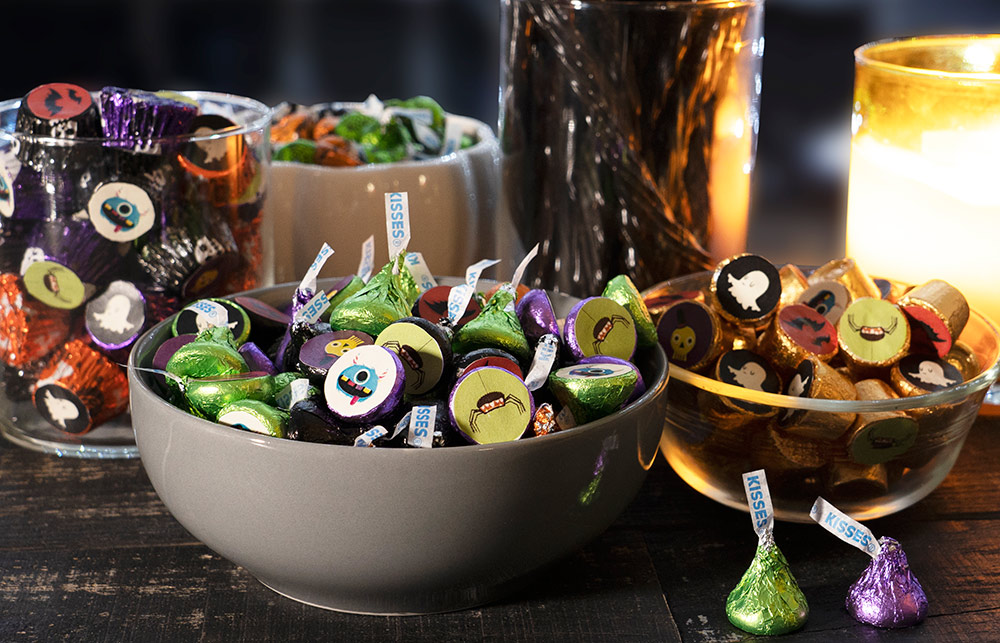疫情之下的万圣节,会成为糖果公司的灾难吗

除了戴着面具的青少年和喜欢迪士尼的小朋友们,没有人比糖果和巧克力生产商更喜欢万圣节。
万圣节热销商品M&M’s和士力架(Snickers)等品牌的母公司玛氏(Mars)会提前两年为这个重要的日子做准备。在万圣节五大糖果品牌中,好时(Hershey)凭借其同名巧克力、锐滋(Reese’s)和奇巧巧克力(Kit Kat)独占其三。万圣节在公司年销售额中的占比高达10%。好时全球首席销售官施朗飞表示:“这是一个重要的场合。”
但这个独具美国特色的节日可能成为又一个被新冠疫情破坏的传统。杰富瑞集团(Jefferies)分析师罗布•迪克森表示:“有太多不确定性。主要问题是万圣节是否会变成一场灾难。”
问题的关键在于“不给糖就捣蛋”这种习俗。玛氏箭牌(Mars Wrigley)公司事务副总裁杰西卡•阿德尔曼表示:“这种习俗需要所有人到户外去与陌生人互动,这与目前政府对民众的要求截然相反。”
哈里斯民意调查机构(Harris Poll)最近受美国国家糖果制造商协会(National Confectioners Association)委托进行的调查,将给糖果公司带来一丝希望:调查结果显示,74%的“千禧一代妈妈”和年轻家长表示,今年的万圣节比以往更重要。
上个月,好时首席执行官米歇尔•巴克在公司营收电话会议上表示:“我们认为消费者会找到有创意并且安全的方式继续‘不给糖就捣蛋’的习俗。这是一种户外活动,而且许多人本身就配戴了面具。”她补充说,如果参加“不给糖就捣蛋”的人少于预期,好时将把重点转向“给自己的礼物和糖果罐等场合”,也就是业内所说的人们自己购买糖果自己享用。
自己享用一直在万圣节的糖果消费中占有很大比例,今年或许会拯救糖果制造商的销售。对于糖果制造业而言,万圣节不止是一天,而是长达10周、购买糖果的节日。迪克森表示,万圣节从根本上来说就是“买糖的借口”。
例如,好时报告称,消费者购买糖果自己享用所带来的销售收入,占万圣节糖果销售额的近50%。这些消费者早在万圣节之前就已经开始采购,另一半糖果销售发生在10月最后两周,主要用于“不给糖就捣蛋”。
好时从5月开始收到零售商的万圣节订单。该公司表示,到目前为止,这些订单的销售情况令人满意。施朗飞表示,鉴于复活节的成功,他对万圣节同样保持乐观。复活节正值疫情高潮时期,但消费者选择了用不同方式庆祝这个节日,在家里举办了更多活动。他预计万圣节将是同样会增加居家消费。他说:“糖果这类商品很有弹性。”
新冠疫情已经在许多方面证明了该行业的实力,例如消费者在囤积罐头浓汤和花生酱的同时采购了大量糖果和巧克力。在上一次营收电话会议中,好时报告称“自疫情爆发以来,每天的巧克力销售额持续增长9%。”
费列罗(Ferrero)品类管理和市场研究副总裁菲尔•德孔托表示,今年万圣节早期的节日季销售数据与前几年的水平相当。费列罗在美国有Butterfinger、Crunch和Baby Ruth等多个品牌。他说:“让我感到心安的是,市场正在走向正轨,购物者与往年一样在采购糖果。”
但为了减少任何潜在风险,公司依旧在调整计划。好时正在减少季节性产品的产量,比如锐滋的Pumpkins系列,增加传统产品和包装产品的生产,因为这些产品即使有剩余库存也更容易清仓。亿滋国际(Mondelēz International)预计消费者更愿意购买家庭装,而不是用于不给糖就捣蛋的散装糖果。
玛氏箭牌甚至推出了一款名为Treat Town的应用,用户可以“以虚拟方式进行不给糖就捣蛋,获得真实的糖果。”消费者可以购买和获取积分,这些积分可以向零售商换购公司的商品。另外,玛氏箭牌与国家安全委员会(National Safety Council)合作制定了在疫情期间庆祝万圣节的安全指南。
不止是“不给糖就捣蛋”可以转移到线上。费列罗的德孔托认为咨询公司凯度(Kantar)的统计数据显示,在停工之后的前五周,在线销售的采用率相当于过去五年的总和。他说,在线销售从“未来的战略工具变成了当前的战略工具。”
万圣节期间将延续这种趋势。好时预测,万圣节期间,路边自提和送货上门订单将占总销售额的15%至20%。
迪克森:“我感觉人的心理是极其复杂的。但我并不认为有任何人敢说万圣节会彻底消失。”(财富中文网)
翻译:刘进龙
审校:汪皓
除了戴着面具的青少年和喜欢迪士尼的小朋友们,没有人比糖果和巧克力生产商更喜欢万圣节。
万圣节热销商品M&M’s和士力架(Snickers)等品牌的母公司玛氏(Mars)会提前两年为这个重要的日子做准备。在万圣节五大糖果品牌中,好时(Hershey)凭借其同名巧克力、锐滋(Reese’s)和奇巧巧克力(Kit Kat)独占其三。万圣节在公司年销售额中的占比高达10%。好时全球首席销售官施朗飞表示:“这是一个重要的场合。”
但这个独具美国特色的节日可能成为又一个被新冠疫情破坏的传统。杰富瑞集团(Jefferies)分析师罗布•迪克森表示:“有太多不确定性。主要问题是万圣节是否会变成一场灾难。”
问题的关键在于“不给糖就捣蛋”这种习俗。玛氏箭牌(Mars Wrigley)公司事务副总裁杰西卡•阿德尔曼表示:“这种习俗需要所有人到户外去与陌生人互动,这与目前政府对民众的要求截然相反。”
哈里斯民意调查机构(Harris Poll)最近受美国国家糖果制造商协会(National Confectioners Association)委托进行的调查,将给糖果公司带来一丝希望:调查结果显示,74%的“千禧一代妈妈”和年轻家长表示,今年的万圣节比以往更重要。
上个月,好时首席执行官米歇尔•巴克在公司营收电话会议上表示:“我们认为消费者会找到有创意并且安全的方式继续‘不给糖就捣蛋’的习俗。这是一种户外活动,而且许多人本身就配戴了面具。”她补充说,如果参加“不给糖就捣蛋”的人少于预期,好时将把重点转向“给自己的礼物和糖果罐等场合”,也就是业内所说的人们自己购买糖果自己享用。
自己享用一直在万圣节的糖果消费中占有很大比例,今年或许会拯救糖果制造商的销售。对于糖果制造业而言,万圣节不止是一天,而是长达10周、购买糖果的节日。迪克森表示,万圣节从根本上来说就是“买糖的借口”。
例如,好时报告称,消费者购买糖果自己享用所带来的销售收入,占万圣节糖果销售额的近50%。这些消费者早在万圣节之前就已经开始采购,另一半糖果销售发生在10月最后两周,主要用于“不给糖就捣蛋”。
好时从5月开始收到零售商的万圣节订单。该公司表示,到目前为止,这些订单的销售情况令人满意。施朗飞表示,鉴于复活节的成功,他对万圣节同样保持乐观。复活节正值疫情高潮时期,但消费者选择了用不同方式庆祝这个节日,在家里举办了更多活动。他预计万圣节将是同样会增加居家消费。他说:“糖果这类商品很有弹性。”
新冠疫情已经在许多方面证明了该行业的实力,例如消费者在囤积罐头浓汤和花生酱的同时采购了大量糖果和巧克力。在上一次营收电话会议中,好时报告称“自疫情爆发以来,每天的巧克力销售额持续增长9%。”
费列罗(Ferrero)品类管理和市场研究副总裁菲尔•德孔托表示,今年万圣节早期的节日季销售数据与前几年的水平相当。费列罗在美国有Butterfinger、Crunch和Baby Ruth等多个品牌。他说:“让我感到心安的是,市场正在走向正轨,购物者与往年一样在采购糖果。”
但为了减少任何潜在风险,公司依旧在调整计划。好时正在减少季节性产品的产量,比如锐滋的Pumpkins系列,增加传统产品和包装产品的生产,因为这些产品即使有剩余库存也更容易清仓。亿滋国际(Mondelēz International)预计消费者更愿意购买家庭装,而不是用于不给糖就捣蛋的散装糖果。
玛氏箭牌甚至推出了一款名为Treat Town的应用,用户可以“以虚拟方式进行不给糖就捣蛋,获得真实的糖果。”消费者可以购买和获取积分,这些积分可以向零售商换购公司的商品。另外,玛氏箭牌与国家安全委员会(National Safety Council)合作制定了在疫情期间庆祝万圣节的安全指南。
不止是“不给糖就捣蛋”可以转移到线上。费列罗的德孔托认为咨询公司凯度(Kantar)的统计数据显示,在停工之后的前五周,在线销售的采用率相当于过去五年的总和。他说,在线销售从“未来的战略工具变成了当前的战略工具。”
万圣节期间将延续这种趋势。好时预测,万圣节期间,路边自提和送货上门订单将占总销售额的15%至20%。
迪克森:“我感觉人的心理是极其复杂的。但我并不认为有任何人敢说万圣节会彻底消失。”(财富中文网)
翻译:刘进龙
审校:汪皓
Other than mask-wearing tweens and Disney-loving toddlers, no one obsesses more about Halloween than candy and chocolate makers.
Mars, the company behind Halloween staples like M&M’s and Snickers, starts its planning for the big day two years in advance. For Hershey—which has three of the top five Halloween brands in its namesake chocolate, Reese’s, and Kit Kat—the holiday represents 10% of the company’s annual sales. “It’s big,” says Phil Stanley, Hershey’s global chief sales officer.
But the uniquely American holiday is just the latest tradition that COVID-19 has the potential to thwart. “There’s a lot of uncertainty,” says Jefferies analyst Rob Dickerson. “The main question—is Halloween going to be a disaster or not?”
The obvious issue at play: trick-or-treating. “It’s designed to have you go out and interact with strangers en masse, which is the exact opposite of what everyone is being told to do right now,” says Jessica Adelman, vice president of corporate affairs at Mars Wrigley.
A recent survey conducted by the Harris Poll on behalf of the National Confectioners Association is giving candy companies a sign of hope: The results found that 74% of "millennial moms" and young parents say Halloween is more important than ever this year.
“We think that consumers will find creative and safe ways to trick-or-treat. It is an outdoor event, and it’s an event where a lot of masks are already worn,” said Hershey CEO Michele Buck on the company’s earnings call last month. She added that if trick-or-treating is lower than expected, Hershey will focus on the “Treat for Me and Candy Bowl occasion”—industry-speak for people buying candy that they will end up eating themselves.
Self-consumption has always been a massive part of the holiday and may end up salvaging sales for candy makers this year. Halloween isn’t a single day for the industry but rather a 10-week treat-buying fest. The holiday is basically an “excuse to buy candy,” says Dickerson.
Hershey, for example, has reported that people buying goodies to eat themselves makes up nearly 50% of sales at Halloween. Those purchases begin well before the holiday, with the other half of the season’s sales occurring in the last two weeks of October and designated for trick-or-treating.
Hershey starts receiving Halloween orders in May from retailers and says that it is so far pleased with how those sales are tracking. Stanley says he’s also optimistic based on how Easter panned out. The holiday took place at the height of the pandemic, but consumers just celebrated differently, with more events taking place at home. He expects the same for Halloween, which could drive up even more at-home consumption. “It’s a resilient category,” he says.
The pandemic in many ways has already showcased the strength of the sector, with consumers stockpiling candy and chocolate along with their canned soup and peanut butter. Hershey on its last earnings call reported that "everyday chocolate sales have consistently grown 9% since the pandemic began."
Phil DeConto, vice president of category management and shopper insights at Ferrero, which is behind brands in the U.S. like Butterfinger, Crunch, and Baby Ruth, says that the very early seasonal sales data is on par with prior years. “I take peace in that it’s getting on the floor and that shoppers are finding and purchasing it in line with any other year,” he says.
But companies are still adjusting their plans to mitigate any potential risk. Hershey is scaling back its production of seasonal treats—think items like Reese’s Pumpkins—in favor of traditional products and packaging, which are easier to sell off if inventory is left over. Mondelēz International expects that consumers will be seeking out family-size packs rather than individual pieces for trick-or-treating.
Mars Wrigley is even going so far as to launch an app called Treat Town, which allows users to “virtually trick-or-treat for real candy.” Consumers can buy and earn credits that they will be able to redeem at retailers for the company’s products. It’s also partnering with the National Safety Council to develop guidelines for safe ways to celebrate Halloween amid the pandemic.
It’s not just the trick-or-treating that could move online. Ferrero’s DeConto points to stats from consultancy Kantar that indicate that online sales experienced the equivalent of five years’ worth of adoption in the first five weeks of the shutdown. It’s gone from a “strategic lever for the future to a strategic lever for right now,” he says.
That’s likely to continue during Halloween, with Hershey expecting that curbside pickup and home delivery will make up 15% to 20% of the season’s sales.
“My sense is that the human psyche works in complicated ways,” says Dickerson. “But I don’t think anybody can say there will be no Halloween.”













